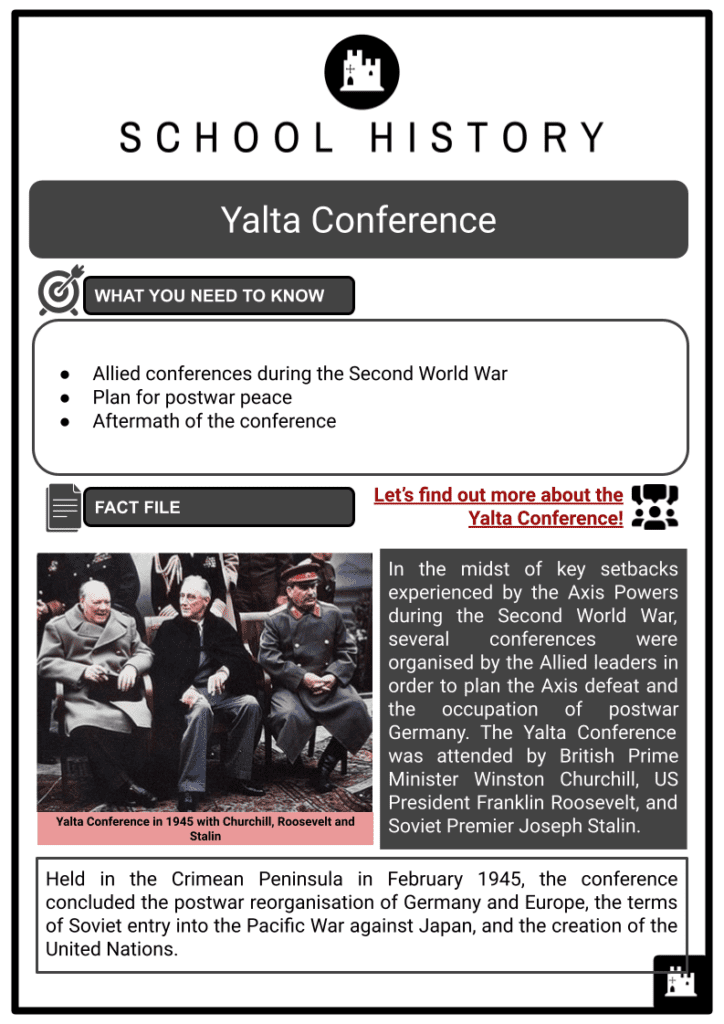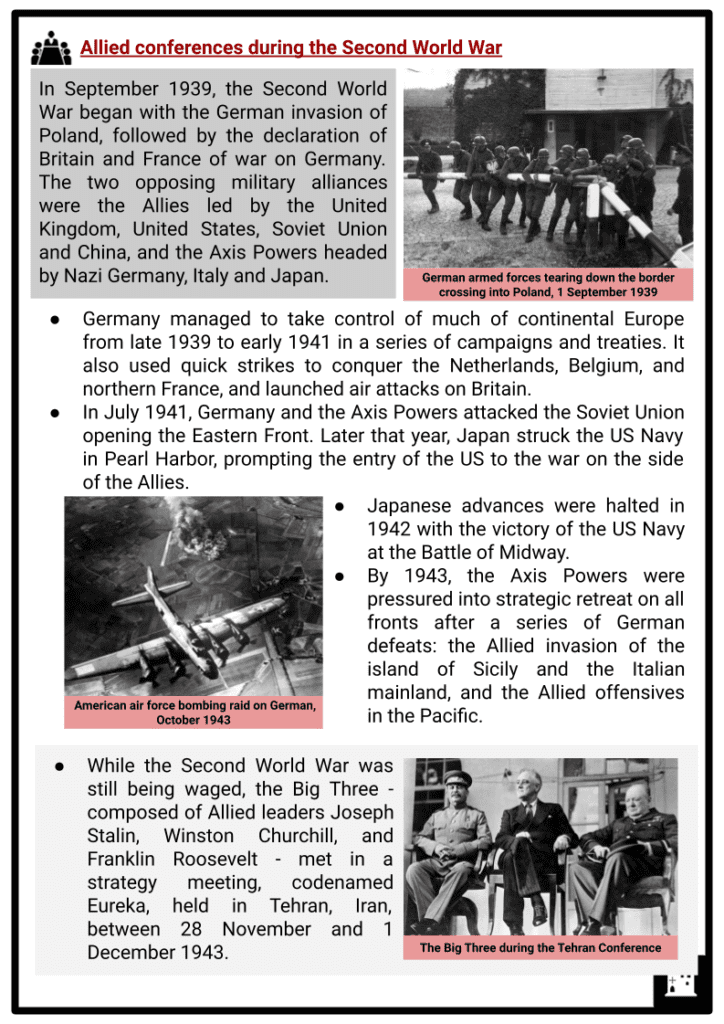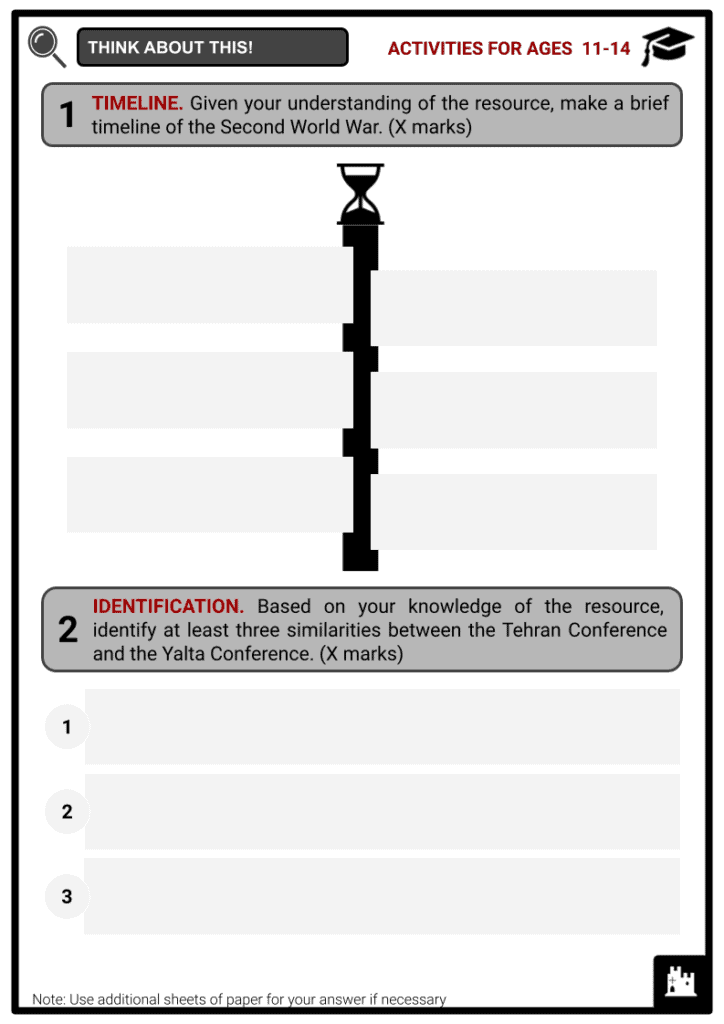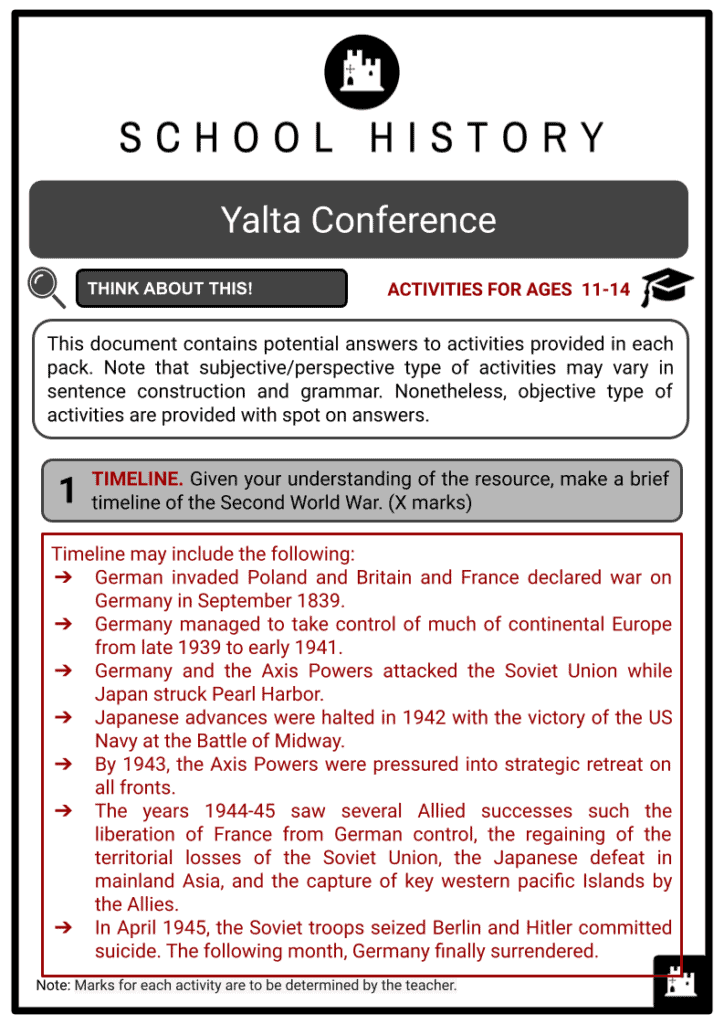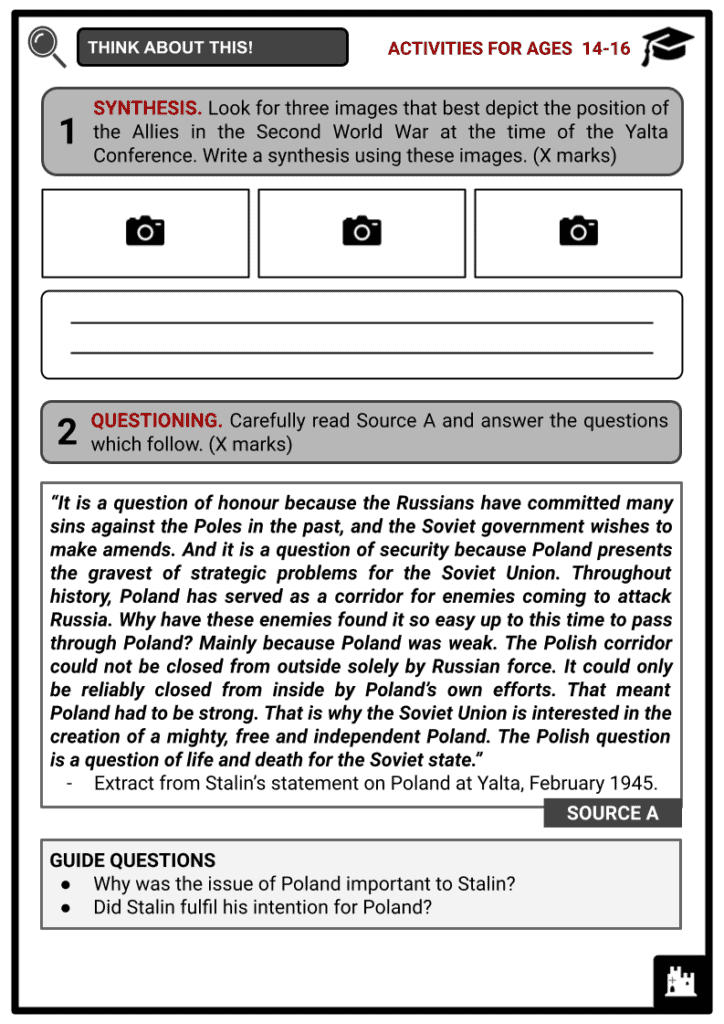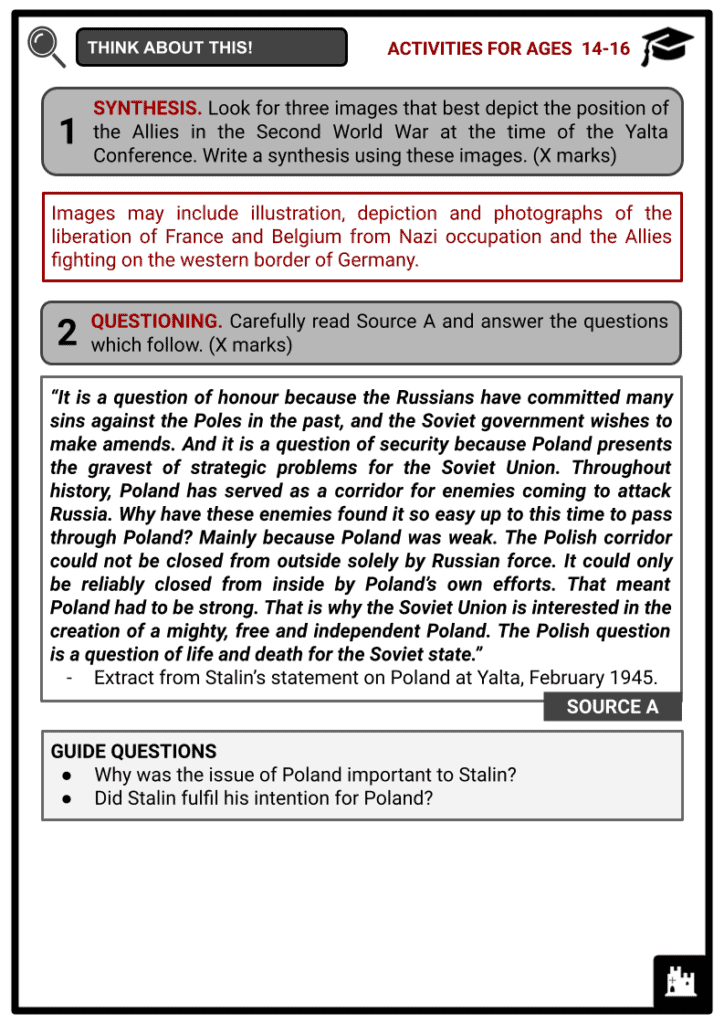Yalta Conference Worksheets
Do you want to save dozens of hours in time? Get your evenings and weekends back? Be able to teach about the Yalta Conference to your students?
Our worksheet bundle includes a fact file and printable worksheets and student activities. Perfect for both the classroom and homeschooling!
Summary
- Allied conferences during the Second World War
- Plan for postwar peace
- Aftermath of the conference
Key Facts And Information
Let’s find out more about the Yalta Conference!
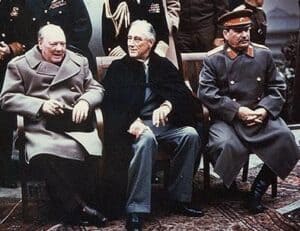
In the midst of key setbacks experienced by the Axis Powers during the Second World War, several conferences were organised by the Allied leaders in order to plan the Axis defeat and the occupation of postwar Germany. The Yalta Conference was attended by British Prime Minister Winston Churchill, US President Franklin Roosevelt, and Soviet Premier Joseph Stalin.
Held in the Crimean Peninsula in February 1945, the conference concluded the postwar reorganisation of Germany and Europe, the terms of Soviet entry into the Pacific War against Japan, and the creation of the United Nations.
Allied conferences during the Second World War
- In September 1939, the Second World War began with the German invasion of Poland, followed by the declaration of Britain and France of war on Germany. The two opposing military alliances were the Allies led by the United Kingdom, United States, Soviet Union and China, and the Axis Powers headed by Nazi Germany, Italy and Japan.
- Germany managed to take control of much of continental Europe from late 1939 to early 1941 in a series of campaigns and treaties. It also used quick strikes to conquer the Netherlands, Belgium, and northern France, and launched air attacks on Britain.
- In July 1941, Germany and the Axis Powers attacked the Soviet Union opening the Eastern Front. Later that year, Japan struck the US Navy in Pearl Harbor, prompting the entry of the US to the war on the side of the Allies.
- Japanese advances were halted in 1942 with the victory of the US Navy at the Battle of Midway.
- By 1943, the Axis Powers were pressured into strategic retreat on all fronts after a series of German defeats: the Allied invasion of the island of Sicily and the Italian mainland, and the Allied offensives in the Pacific.
- While the Second World War was still being waged, the Big Three - composed of Allied leaders Joseph Stalin, Winston Churchill, and Franklin Roosevelt - met in a strategy meeting, codenamed Eureka, held in Tehran, Iran, between 28 November and 1 December 1943.
- The Tehran Conference was the first of the Second World War conferences of the Big Three.
- The Allied leaders appeared to have differing aims in attending the meeting. Nevertheless, they arrived at several decisions.
- The conference concluded with the following resolutions:
- Yugoslav Partisans should be supported through commando operations and supplies.
- Persuasion of Turkey to join the war on the side of the Allies.
- Launching of Operation Overlord in May 1944 as a cross-channel invasion of France.
- Establishment of cooperative relations between the military staff of the Soviet Union, UK, and US, especially in operations in Europe.
- The Soviet Union had agreed in principle to join the war against Japan in the Pacific within three months of Germany’s defeat.
- Division of postwar Germany was deemed necessary to neutralise its ability to wage war.
- Another conference was held in October 1944 in Moscow to decide on a timetable for Soviet Union to enter the war against Japan.
- Known as the Tolstoy Conference, it was attended by Churchill, Stalin and a couple of US representatives. Stalin thought it was more important to discuss postwar balance of power in the Balkans.
- In this meeting, Churchill secretly proposed to Stalin the division of postwar Romania, Greece, Yugoslavia, Hungary and Bulgaria between the Allied powers. The future of Poland was also raised.
- The issues discussed at the Tolstoy Conference were not easily resolved. Moreover, nothing came of the proposed meeting between the leader of the exiled Polish government and the Soviets to settle the Polish-Soviet frontier.
Plan for postwar peace
- The years 1944-45 saw several Allied successes such the liberation of France from German control, the regaining of the territorial losses of the Soviet Union, the Japanese defeat in mainland Asia, and the capture of key western pacific Islands by the Allies. In February 1945, the Big Three met near Yalta in Crimea, Soviet Union to determine the postwar reorganisation of Germany and Europe.
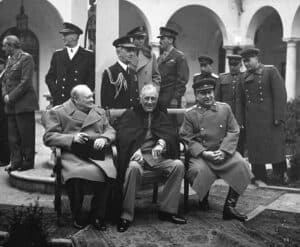
The Big Three at the Yalta Conference - The principal aim of what became known as the Yalta Conference was to frame postwar peace and the re-establishment of the nations of war-torn Europe. The conference was the second wartime meeting attended by the Big Three.
- During this time, France and Belgium had been liberated from Nazi occupation and the Allies were fighting on the western border of Germany.
- Similar to the previous conferences, each Allied leader had his own agenda:
- Churchill urged for free elections and democratic governments in Central and Eastern Europe, particularly in Poland.
- Roosevelt sought the confirmation of the support of the Soviet Union in the planned invasion of Japan in an effort to curb the length of and the extent of damage sustained in that conflict.
- Stalin called for a Soviet sphere of political influence in Eastern and Central Europe as a vital aspect of the Soviets’ national security measure.
- During the Yalta Conference, the Declaration of Liberated Europe was established by the Allied leaders, pledging to permit the people of Europe “to create democratic institutions of their own choice”.
- The following key points were also established:
- Germany would be split into occupied zones administered by the UK, US, French, and Soviet forces.
- Germany would undertake demilitarisation and denazification in the hope to provide safeguards against a potential military revival of Germany. War criminals would be punished and German militarism would be eradicated.
- Forced labour of Germans would serve as war reparations for the damage that Germany had inflicted on its victims. A reparation council was to be formed in the Soviet Union.
- The communist Provisional Government of the Republic of Poland, installed by the Soviet Union, was recognised. The Polish eastern border would keep to the Curzon Line, and Poland would secure territorial compensation in the west from Germany.
- Free elections in all liberated European and former Axis satellite countries would be permitted such as in the case of Poland.
- Stalin agreed to support the US in the invasion of Japan in exchange for Southern Sakhalin and the Kuril Islands, as well as railroad rights in Manchuria and two water ports.
- The United Nations would be created with the cooperation of the Allies.
- Having negotiated these key points, the Allied leaders agreed on meeting again after the surrender of Germany, in order to conclude the borders of postwar Europe and other remaining issues.
Aftermath of the conference
- Churchill believed that Stalin would keep his side of the bargain. In a parliamentary debate held in February 1945, he was criticised by numerous MPs with some outlining an amendment protesting the agreement at Yalta. At the same time, Roosevelt was also condemned for the concessions he made at the conference, particularly regarding the Soviet influence in Eastern Europe and Northeast Asia.
- Stalin’s actions in March 1945 made it clear to the other Allied leaders that he would not honour his promise of political freedom in Poland, Czechoslovakia, Hungary, Romania, Bulgaria and Albania.
- Instead, democratic elections were never held, communist governments were set up in all those countries, and non-communist political parties were subdued. Poland, Czechoslovakia, Hungary, Romania, Bulgaria, Albania and East Germany would be later converted into Soviet-controlled satellite states.
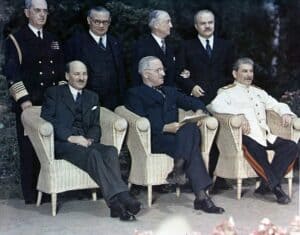
Attlee, Truman and Stalin at Potsdam Conference - In April 1945, the Soviet troops seized Berlin and Hitler committed suicide. The following month, Germany finally surrendered.
- Another meeting was held from July to August 1945 known as the Potsdam Conference.
- It was attended by Stalin, Churchill and later by his replacement Clement Attlee, and Harry Truman who succeeded Roosevelt.
- It began under a cloud of mistrust. In fact, Truman became far more suspicious of Stalin.
- Meanwhile, Stalin managed to effectively ratify the concessions he won at Yalta as his troops had occupied much of Germany and Eastern Europe.
- In March 1946, Churchill declared that an “iron curtain” had fallen across Eastern Europe. This marked a decisive conclusion to the cooperation between the Soviet Union and its Western allies.
Image Sources
- https://upload.wikimedia.org/wikipedia/commons/5/5e/Yalta_Conference_cropped.jpg?20090415212642
- https://upload.wikimedia.org/wikipedia/commons/thumb/0/05/Yalta_Conference_%28Churchill%2C_Roosevelt%2C_Stalin%29_%28B%26W%29.jpg/800px-Yalta_Conference_%28Churchill%2C_Roosevelt%2C_Stalin%29_%28B%26W%29.jpg
- https://upload.wikimedia.org/wikipedia/commons/thumb/a/af/Potsdam_conference_1945-8.jpg/800px-Potsdam_conference_1945-8.jpg

